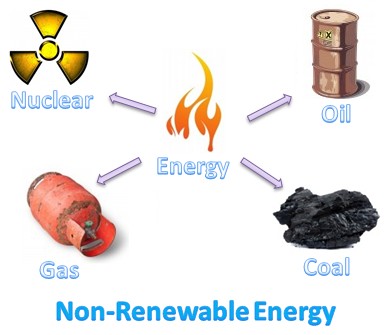Non-Renewable Sources of Energy
Some reliable source of energy is very important for many industrial countries now days. These energies are utilized for cooking, heating, manufacturing
and transport purposes. The energy can be commonly classified as renewable or non-renewable. All over eighty-five percentage of the energy used in the
globe is from non-renewable sources. Many developed countries are dependent on non-renewable (unrenewable) energy sources such as nuclear power and fossil
fuels (oil and coal) and these sources are known as non-renewable because they can't be regenerated or renewed rapidly enough to keep pace with their
practice.

Few sources of energy are renewable or potentially inexhaustible. Some of inexhaustible energy sources are: - wind, solar, geothermal, hydroelectric, biomass. The renewable energy sources are more generally by used in developing countries.
Coal
The coal is the most plentiful fossil fuel in the Earth with an estimated reserve of 1 trillion tones. Many of the globe coal reserves exist in Asia and
Eastern Europe, just the United States as well has considerable amount of coal reserves.
The coal formed slowly over millions of yrs from the buried
remaining of historical swamps and during the formation of coal fuel, the carbonaceous matter was 1st compressed into a soft material known as 'peat', that
is about ninety percent of H2O. Since the peat became more profoundly immersed, increased temperature and force turned it into coal fuel.
Oil
The liquid petroleum or crude oil is a fossil fuel that is refined into many other energy productions (for example. Petrol, diesel fuel, jet fuel, fuel
oil). The oil forms in the below earth's crust in rocks such as shale and which is rich in organic substances. Later the oil makes, this migrates upward
into leaky source rock such as limestone or sandstone, wherever it can become unfree by an overlying impermeable cap rock (stone).
The wells are drilled
into these oil sources to remove the oil and gas. Across seventy percentages of oil field is found near the tectonic boundary plates, since the conditions
there are conducive to formation of oil.
Natural Gas
The natural gas product is frequently a by-product of recovery of oil, since both of them commonly share underground sources. The natural gas is a mixture of gases together and the most common being CH4 (methane). This as well contains some (C2H5) ethane, (C3H8) propane and (C4H10) butane. The natural gas is usually not polluted with sulfur and is hence the cleanest burning fuel of fossil.
Nuclear Power
In many power plants the water is boiled and turned into steam that forces a turbine generator to create electrical energy. The fossil fuel power stations create heat by combusting natural gas, oil or coal. On a nuclear power station the atoms of uranium fission in the nuclear reactors supplies the heat to develop steam for getting electrical energy.





